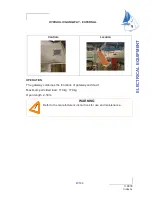
101/154
119635
Index G
ELECTRICAL CIRCUIT, 110-220 V
GENERAL RECOMMENDATIONS
Certain vessels are equipped (as either standard or optional features depending on
the model)with a 110 V or 220 V circuit.
The following measures are recommended in order to avoid the danger of electrical shock
and fire:
- Never work on a live electric fitting.
- The cutting power 220V-110V (dock or generator) does not cut the power converter: It
is imperative to switch the converter OFF before handling devices or 220V-110V.
- Plug in the boat/shore supply cable in the boat before you plug it into the shore supply
socket.
- Never let the end of the boat/shore supply cable hang in the water.
- Turn off the shore supply with the onboard cut-off switch before connecting or
disconnecting the vessel/shore supply line.
- Disconnect the ship/shore power cable at the shore socket first.
- Check the polarity indicator for the shore connections (110V AC version).
- If the reverse polarity indicator is activated immediately disconnect the cable. Rectify
the polarity fault before using the vessel's electrical installation.
- Close the shore supply input cover firmly after use.
- Do not modify the vessel/shore supply line connections; only use compatible
connections.
- Do not alter the vessel's electrical system. The installation, modifications and
maintenance must be carried out by a qualified marine electricity technician. Check the
system at least twice a year.
- Disconnect the vessel supply when the system is not being used. This is to prevent the
danger of fire.
- Use double insulated or earthed appliances.
Note that the live wires are brown, the neutral ones are blue and the earth wires are green
and yellow.
DANGER
- Never let the end of the boat/shore supply cable hang in the water: The
result may be an electric field liable to hurt or kill the swimmers nearby.
- There may be danger of electrocution if alternating current systems are
incorrectly used.
PRECAUTION
- Never modify an electric fitting and relevant diagrams yourself.
- Call in a technician skilled in marine electricity to carry out any electric modification.
- Never change the breaking capacity (amperage) of the overcurrent safety devices.
- Never install or replace the electric appliances (or any electric equipement) by
components exceeding the capacity (amperage) of the circuit (Watt for bulbs).
9
E
L
E
C
T
R
IC
A
L
E
Q
U
IP
M
E
N
T
Summary of Contents for 53
Page 16: ......
Page 17: ...113 154 119635 Index G ENGINE GENERAL INFORMATION ENGINE FITTING 10...
Page 20: ...116 154 119635 Index G ENGINE FITTING...
Page 42: ...138 154 119635 Index G DIAGRAM LOCATION...
Page 44: ......
Page 48: ......
Page 49: ...145 154 119635 Index G LAUNCHING LAUNCHING RECOMMENDATIONS STEPPING THE MAST 11...
Page 53: ...149 154 119635 Index G WINTER STORAGE LAYING UP PROTECTION AND MAINTENANCE 12...
Page 56: ......
Page 58: ......






































